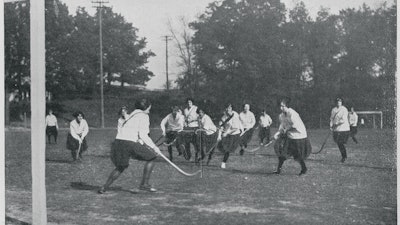
On Feb. 22, 1950, Dr. William N. Wasson organized a meeting of 20 professionals from 11 Historically Black Colleges and Universities to discuss his findings in “A Comparative Study of Intramural Programs in Negro Colleges,” which was funded by the Carnegie Foundation. Out of that two-day meeting emerged the National Intramurals Association (NIA), which eventually morphed into what today is simply known as NIRSA.
With the tagline “Leaders in Collegiate Recreation,” NIRSA is jumping into 2024 with a series of year-long celebrations that will include social media campaigns and reminders about the association’s history.
“We’re going to start our rollout with social media, because that’s where our young members are,” says Lexi Chaput, senior assistant director of sports programs and development for Recreational Sports at the University of Michigan, as well as a member of NIRSA’s History & Legacy Committee. “There will be things like history and facts about the association — ‘This Day in NIRSA History’ — and short features on individuals, with a special focus on creating personal connections with people who have shaped the history of NIRSA.”
People making people better
The calendar already is marked for Feb. 22, which is Recreational Sports & Fitness Day throughout North America, plus NIRSA’s Founders’ Day of Giving. Other recognition efforts will be aimed at promoting campus recreation as a career choice and providing young professionals inspiration and encouragement. All of that — and more — will culminate at the 2025 NIRSA Annual Conference and Campus Rec & Wellness Expo in Kissimmee, Fla., in April 2025.
“If you’ve ever been to a NIRSA event, you know how you feel when you leave — it’s a level of excitement and rejuvenation,” Chaput says. “In-person events are how we often get students committed to the field in a professional sense. Our first-year professionals all the way up to people with 10 years’ experience make up a significant portion of our association membership.”
At its core, NIRSA (and collegiate recreation as a whole) “is in the people-making-people-better business,” says Mark Williams, director of RecSports at the University of Notre Dame and co-chair of the History & Legacy Committee. “That means us as professionals and also all the students we work with. We want to provide transferable skills and extraordinary experiences. For us to have the opportunity to make a difference in students’ lives — it may sound corny, but I think that’s one of the big reasons why we do what we do. A lot of my colleagues are so very intelligent and hard-working that they could be making a lot more money elsewhere. Still, this is what they choose to do, because it makes a difference.”
There’s no arguing NIRSA’s impact over the past seven and a half decades, as the association kept pace with increasing enrollment, the evolution of larger campus recreation centers and the development of more diverse programming. Especially notable is NIRSA’s commitment to inclusion and representation — such as creating professional resources and a wide range of intentional opportunities for connection for people of color and the LGBTQ+ community.
‘We value belonging’
 NIRSA will celebrate its milestone anniversary throughout 2024, with an eye toward the association’s constant improvement moving forward.Photo courtesy of NIRSA
NIRSA will celebrate its milestone anniversary throughout 2024, with an eye toward the association’s constant improvement moving forward.Photo courtesy of NIRSA
“If you’re going to talk about the good things, you need to talk about the bad things, too,” Williams says. “I think what’s key is that the association overcame those bad things. I don’t understand why women weren’t allowed membership, or why the association wasn’t always inclusive for people of color. But the membership eventually rallied and worked together to make changes and become more inclusive. We saw it, we owned it and now we’re trying to keep making it better.”
“Acknowledgement is a critical piece in all this,” Chaput adds. “We don’t have to get lost in details about how things went in the wrong direction. But we certainly don’t want to brush it away, either.”
One element of NIRSA’s history she feels has been overlooked is the high level of education NIA founder Wasson achieved as a Black man in the 1950s. “Those are the kinds of things we need to do more talking about,” Chaput says. “We had this fantastic human being who not only created this association but did so in a way that was atypical of the time. We don’t have a lot of information about the oppression he faced, but you certainly have to assume there was some level of that.”
The efforts of Wasson, who died in 1991, live on in today’s NIRSA. “The legacy, beyond the facts, paints a picture of the direction and values of our association,” Chaput continues. “Clearly, we value belonging — and while we may not have called it that at the time women were reintroduced or once there was a more comfortable place for our LGBTQ+ members to be their authentic selves — the legacy is that we are committed to being advocates and allies, and we’re going in a direction that we should be going.”
And that’s worth celebrating, Williams says.
“We’ve always talked about facilities, about intramural sports, about outdoor experiences and fitness. But now we also talk about the different points of connection — the Black caucus, the Asian caucus, the Latino caucus, the LGBTQ+ caucus — they’re all a part of NIRSA,” he says. “I think that is what’s so good and positive about the organization. You can find your niche, you can find your people, you can find your group. And it’s one big reason why we want to start celebrating NIRSA’s overall legacy and impact this year.”





































